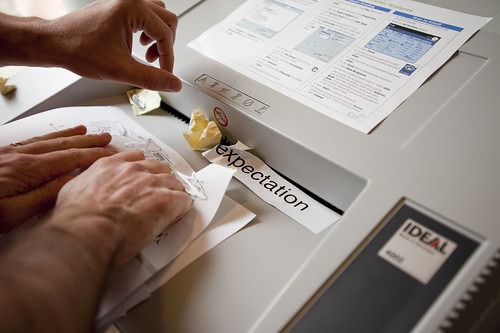
An interesting article in the Harvard Business Review that I came across recently. It is relevant to a long-standing interest in other strategies for “innovation” particularly in commercial enterprises.
The article is called “Fewer Engineers, More Anthropologists” by Navi Radjou. It argues for, like…more anthropologists and fewer engineers while an enterprise attempts to “effectively identify[ing] and address[ing] the explicit and unmet needs of the broader consumer base in emerging markets.” (Quick translation — selling more stuff that makes sense to local people/cultures/practices in Brazil, India, South America and probably Africa, too.)
Why I find this intriguing is how ancient it sounds. If it the article was dated in 1990 I might understand. But it is quite recent, published only this month. This makes me think that something was forgotten, as is the nature of history. This is fine, except along with what was forgotten goes any lessons or insights learned.
If there is something to this idea that big companies are still viable as enterprises that can bring about global scale change and do it quickly enough to help save us from ourselves, then they should go about their ways differently as the old ways will not work to create a more habitable world. (I am not entirely convinced, but okay. They – these big companies – are not going to all go away over night, although some will, certainly, or have, or are on some serious life support.)
If big enterprises are to do things differently — if they are to “innovate” — how do they do this? Back a decade or two ago, they were going to use the social sciences to look at the world differently and to be more people-focused, rather than consumption, or engineering, or accounting, or instrumentally and consumer focused. Anthropologists started participating in the corporate R&D processes, bringing a new set of “optics”, new ways of understanding people and their practices. With these ethnographic and anthropological new understandings and perspectives contributed to the research and the development, engineers would have a whole bullet list of new ideas for devices and services and user-interface designs. Etcetera. The home visit by an ethnographer with a typical consumer would yield unseen practices, desires, aspirations of people which could be addressed in the creation of new, you know — stuff. New opportunities for new services and products and whole markets would appear that could not previously been pulled into focus with the old accounting-and-engineering optics. Etcetera. Strangely, this approach is what the article in HBR refers to as a new kind of R&D..R&D 2.0.
Huh? 2.0? Wha?

Back when I was doing my masters degree in engineering (cue sound effects of rocking chair creeking; slow pan to wistful eyeballs; dissolve to horses and buggies clickity-clacking across cobblestone streets and kids playing with sticks and hoops) I caught wind of this sort of thing where anthropologists and sociologists and even artists were helping Xerox PARC “innovate.” This seemed like an intriguing mix to combine engineering sensibilities and technology principles to creating new things for people. A short time later, I had the chance to study alongside of some anthropologists who were doing precisely this, one of whom was Lucy Suchman who would come around to UC Santa Cruz to help eager-eyed grad students understand the relationship between people, technologies and society — a thing we called technoculture, when that word was fashionable. Natalie Jeremijinko was around, as well, and doing an art-engineering residency at PARC. Suitably intrigued by this sort of weaving together of study/observation practices along with art-technology approaches, it became a loose trajectory to consider. What was going on here? I’m still not entirely sure, but the general idea was that new ways of looking at the world would hopefully lead to “innovation” – a transformation of some sort.
Anthropologists provide different sorts of optics with which “MNC’s” (new one to me, but okay…multinational corporations) can calibrate the product of their corporate body. They can make stuff that will be legible to, and fulfill a need for, local markets. Well-skilled anthropologists have the tools and expertise and insights to observe behavior and deliver insights that can be interpreted and ingested by the guys in the blue shirts and yellow ties.
Other sorts of creative practices can do the same sort of thing, only their optics, their way of seeing the world, turns things a bit on its side. Perhaps this is a more active perspective, rather than a detached observation of the ways and means of a local culture. Finding the points of disruption, the fringes and edges of evolving forms of culture. The creative sort may find the trends not because they are looking for them, like those trendologists or whatever, but because they are participating in the formation of these new practices. They are somewhere in the future, just a bit, which is somewhere those guys in the blue shirts, and the yellow ties are never at, by definition. It’s just their lot in life to wait for things to happen, follow-fast and find a way to skim a bit off the top.
The HBR article does not mention the creative sorts, but looks specifically at what anthropologists and ethnographers have / can contribute to a new kind of R&D 2.0 as it is referred to in the article. These social scientists along with another kind of social scientists called the development economist (who would, I am sure, prefer to be more properly a technical scientist) — together this sort of team can effectively carry out a global R&D 2.0 strategy if only the “CEOs of multinationals..give themselves a target of staffing at least 40% of their R&D labs in emerging markets with sociologists and micro-economists.”
Okay, that’s good stuff on the face of it. At least “R&D 2.0” is not run only by engineerings and accountants, as it continues to be to the best of my knowledge. (The problem there being that engineers are perhaps as out of touch with local social practices, or even how to see such things, or even how to realize that what they think is cool is probably not cool to everyone else.)

The thing of it is, gaaah… This R&D 2.0 strategy appearing in the HBR in June of 2009 is, like…R&D 1.0, really. I mean, if I was hanging around and learning from these swell people back in the 90s, before the dot-com, who were doing exactly what this article is describing, how can it possibly be a 2.0 thing, unless I am really living about a decade or two in the future? You see what I’m saying? If, you know..right now I am circulating and working and sharing amongst people and studios and innovators who are doing something that arguably evolved from the anthro/observations-to-insights-to-innovation style of “R&D”, what the frack is so 2.0 about doing it now, two decades later? Seems kinda, like..ancient to my earballs. Medieval. Perhaps even completely out of touch with what has been well-done and finished and even written about retrospectively in quite a nice collection of normal printed books?
If anything — and lets say I am in the future and that is reason enough for you to pay attention for a few more sentences — what should be paid attention to is the coupling of design to strategy as a new sort of enterprise practice, rather than engineering-to-development. It’s not that the engineering bit is of no use. Not at all. I mean..I’m an engineer and I do engineering-y things all the time. All the time. I have deep stakes there. But I recognize that, when in engineering mode, the sensibilities there are corralled, very disciplined, contain too much hubris, fixate on a target and have no idea how to swerve. Move to quickly. Assume code can translate all experiences, etcetera. But now, if there’s a 2.0 to the ways big enterprises work, at least ones that lead in terms of how they organize themselves around creating solutions to new worldly challenges, leading with design sounds better than leading with engineering. And if you can get designers who can engineer and who have the sensitivities toward people and their practices — that sounds like the right kind of multifaceted perspectives.
So, perhaps R&D 2.0 is really better stated at D&R 2.0, as to mean Design & Research. Anthropology and Sociology as far as I know (I know a bit – I studied with and alongside of a number of them – James Clifford, Donna Haraway, Anna Tsing, Mimi Ito, Lisa Rofel, Lucy Suchman) are great at observation but the translation of observations into “action items” can be rough, at best. In fact, properly speaking, I am not so sure that these disciplines ever meant to become actionable sorts of things, as opposed to disciplines that went forth, observed, developed insights and provided translations of cultural practices and maybe some comparative perspectives (which has always been controversial.) But, looking at a culture and then saying — okay, do this and you’ll have a successful product launch in this out of the way place? Not so sure that works. But, regardless of the role of these social and cultural observational practices, even performing that translation can be a challenge.
What do I mean? Okay. You go out on your Urban Scout adventure, or a junket to a place that your MNC wants to explore as a “new market” and you see some curious practices or objects or services or whatever. And right away, someone wants to know the implications of this for making new things. “Okay – you went out there. You’ve told me and showed me some things. Now..what should I build?” That’s a great conversation to have, but often that translation is ignored, or misunderstood, or it just becomes completely illegible to the other guy because you are describing rituals that are so far from their cubicle that, well…you’re categories and languages and idioms are extraterrestrial.
It’s this thing that often gets pitched as “applied” observation. Like, applied physics, where you take the theory and make it work by cobbling together material artifacts that express the theory as something that articulates and moves and shoots particles all over the place. Or whatever. “Applying” ideas or observations into material form does not always go so well, which is why we have people like Bruno Latour to remind us of the way all objects are always already social, right? I mean..look at that crazy super collider thing there in the EU. The theory is great, probably. It would most likely find exactly what it was designed to find because theory fulfills its own wishes, but…how do you actually throw the switch and boot the damn thing up? Its more than writing clean code or digging a gigantic ditch. Right?
Why do I blog this? I am curious about that bit in between observations and implications and materialization practices — the translation of things-seen into things-made seems to me to require an additional set of practices and crafts that, so far as I can tell right now from the near future we here at the Laboratory inhabit is what this D&R 2.0 is doing, right now, in the future. Many of the practices that are at the fringes are precisely the observation/insight/crafting practices that seem to me more appropriate to creating new, innovative artifacts and experiences. These practices are something that are part of the aspirations and capabilities of an evolving undisciplined, border-crossing, trouble-making collective of designers (loosely) who have developed a set of keen-observational skills but are also able to translate those observations through material craft practices. They can observe-make-think-with-material at one time, and are keenly aware of the significance of doing so. What is that? To create more habitable worlds. And that, hopefully, can also happen when these MNC-bots pay attention to the future rather than just the 9-18 month vision of accountants and engineers.
The other reason I blog this is to remind myself to be wary of anything the purports to be a two-point-oh of anything else.
Hear hear, on all of it. Couldn’t help but feel that there was not just nothing new there in the HBR article, but isn’t that received practice today? I think I might even go further and suggest that the problems of translation from observation to prototype to product and business practice are some of the hardest ones for MNCs (gulp, indeed) to grapple with. It all gets lumped in as “tech transfer”, a strange phrase.
On the other hand, that whole process does seem to be the only way that corporations can survive major changes. Companies make a thing or provide a service; corporations have the goal of the continued survival of the corporation. You know, moving from paper to rubber boots to rubber-covered cables for phones to phones to cellphones to…
Right? I mean…does not at all seem like a 2.0 thing..the thing here is, you know – I’m not hatin’ on the polydisciplinarity thing of bringing together developmental economists (not sure what they are, but sounds right) and anthropologists and sociologists. But, I do wonder about the strict disciplinarity of this. Putting that question aside, and its still a question, and to your point about corporate survival and how this can happen — I wonder how much of the old ways of doing things and the old people who did them can productively contribute to doing things differently. How do you move from a place of comfort to one of complete and utter terror because you are off and doing things differently, perhaps following other kinds of people, learning new idioms and languages and using other kinds of decision making tools, etc.? To your point about places that once made paper and rubber boots and cellphones and internet-y things. Etcetera.
Large(ish) companies tend to be led by engineers (gasp!)or finance folks. They also tend to put engineers in charge of product development, and rarely let design or marketing people anywhere near the process.
So for them it’s still news. Indeed, 20 years later it’s still news.
Which is why you tend to see small innovative companies come up with cool innovative products (www.trunki.com). Those would be companies built around products which are in turn built around insights into the culture/habits/behaviours which are not available to engineers.
As for R&D 2.0 – check out http://www.redesignme.com.
P.S. Don’t get me wrong – I love engineers – though on occasion they frustrate the life out of you, they are a pleasure to work with 🙂